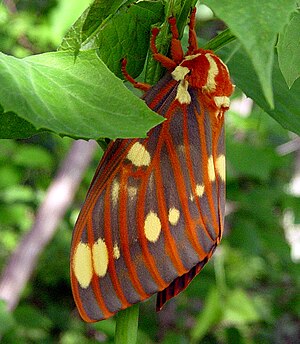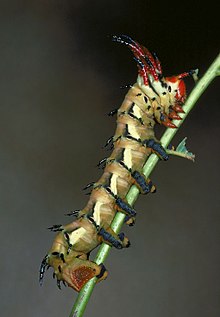Citheronia
| Citheronia | ||||||||||
|---|---|---|---|---|---|---|---|---|---|---|

|
||||||||||
| Systematics | ||||||||||
|
||||||||||
| Scientific name | ||||||||||
| Citheronia | ||||||||||
| Huebner , 1819 |

Citheronia is a genus of butterflies from the family of the peacock moth (Saturniidae). There are 21 species known.
features
The moths are relatively large and have a strong body. Adult Citheronia regalis reach a wingspan of 9.5 to 15.5 cm. Their color ranges from orange to brown, with most species having a conspicuous yellow or white pattern. The front wings are elongated and give the animals a certain resemblance to swarmers . Some species have discal spots . The hind wings are rounded and proportionally somewhat reduced. The antennae of the males are double-pinnate, those of the females are thread-like.
Initially, the processes (scoli) on the back of the caterpillars of all species of the genus are relatively large. These Scoli have given them the common English name "horned devils" ("horned devils"). The caterpillars are very imposing in their appearance and can be over 150 millimeters long.
Occurrence
The genus is widespread on the two American continents. The distribution area extends from the temperate northeast of the United States across Central America and south to large parts of South America. The main distribution area is the Neotropic , in the United States only three species occur ( Citheronia regalis , Citheronia sepulcralis and Citheronia splendens ). There is historical evidence of a fourth species which, due to its proximity in Mexico, can be attributed to either Citheronia mexicana or Citheronia beledonon .
Way of life
The females lay their large, yellowish, transparent eggs in groups of two to six on the host plants. The growing caterpillar can be clearly seen through the egg shell. After the fifth caterpillar stage, they pupate in a chamber in the ground. The pupa hibernates there .
species
The Natural History Museum's Global Lepidoptera Names Index lists the following species in the genus:
- Citheronia andina Lemaire , 1971
- Citheronia azteca Schaus , 1896
- Citheronia beledonon Dyar , 1912
- Citheronia brissoti Boisduval , 1868
- Citheronia claveryi Bouvier , 1924
- Citheronia collaris Rothschild , 1907
- Citheronia consobrina Rothschild , 1907
- Citheronia guayaquila Schaus , 1927
- Citheronia hamifera Rothschild , 1907
- Citheronia johnsoni Schaus , 1928
- Citheronia laocoon Cramer , 1777
- Citheronia lichyi Lemaire , 1971
- Citheronia lobesis Rothschild , 1907
- Citheronia mexicana Grote & Robinson , 1866
- Citheronia mogya Schaus , 1920
- Citheronia phoronea Cramer , 1779
- Citheronia pseudomexicana Lemaire , 1974
- Citheronia regalis (Fabricius , 1793)
- Citheronia sepulcralis Grote & Robinson , 1865
- Citheronia splendens (Druce , 1886)
- Citheronia vogleri Weyenbergh , 1878
supporting documents
Individual evidence
- ↑ a b c d P. M. Tuskes, JP Tuttle, MM Collins: The Wild Silkmoths of North America. A Natural History of the Saturniidae of the United States and Canada . Ed .: George C. Eickwort. 1st edition. Cornell University Press, Ithaca / London 1996, ISBN 0-8014-3130-1 , pp. 59 f . (English).
- ↑ The Global Lepidoptera Names Index - Citheronia ( page no longer available , search in web archives ) Info: The link was automatically marked as defective. Please check the link according to the instructions and then remove this notice.
literature
- PM Tuskes, JP Tuttle, MM Collins: The Wild Silkmoths of North America. A Natural History of the Saturniidae of the United States and Canada . Ed .: George C. Eickwort. 1st edition. Cornell University Press, Ithaca / London 1996, ISBN 0-8014-3130-1 (English).
Web links
- Lepidoptera and some other lifeforms (English)
- The King of the Poets: Citheronia Regalis . Chapter 15 from Gene Stratton Porter's "Moths of the Limberlost" (1912, English).
- Regal Moth on the UF / IFAS "Featured Creatures" website
